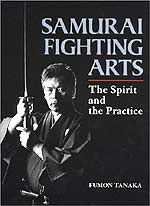Book Review
Samurai Fighting Arts: The Spirit and The Practice
by Fumon Tanaka
New York: Kodansha America, Inc.
Clothbound. Illustrated. 230 pages. 10-1/2” x
8”
$35.00

Review Deborah Klens-Bigman, Ph.D.
Most Westerners over the age of 12, at least, know that Japan has been
a modern nation since the mid-19th century. Men of the samurai
class no longer walk around in kimono and hakama, swords thrust through
their belts and topknots on their heads. However, visions of samurai
knights-errant still inhabit video games, television shows, the theatre,
movies and yes, books.
Fumon Tanaka asks you to suspend belief in modern reality for a short
time,and dive into the world of the warrior in Samurai Fighting Arts:
The Spirit and the Practice. Without a firm understanding of contemporary
Japan, the reader might be understandably transported to a world where
the bushido ideal endures, along with swords, spears, and people hanging
out at the castle clad for battle in their o-yoroi (armor).
Leaving aside the romantic sheen, there are some things to enjoy and
learn from this book. Tanaka considers, especially at the beginning,
certain elements of what we have come to think of as samurai culture,
from ways of dressing to a very nice photo essay on how traditional swords
are made. He draws connection of theatrical performances to the
warrior classes of the Heian, Kamakura and Edo periods. He also
spends some time discussing weapons and techniques of branches of the
Niten Ichi ryu and Shinkage ryu. All of these aspects are fascinating;
unfortunately, they are only very briefly and thinly sketched.
The approach is refreshing, but it is only the buildup to the major
part of the book - an outline of the techniques of the Honmon Enshin
ryu style of iai (sword-drawing). Tanaka is very honest in saying
that the style developed in the early 20th century, though he strongly
states that the techniques go back to hoary antiquity, virtually unchanged
in spirit since those times when men and women fought for survival (and,
maybe later, for honor). The constant argument for authenticity
is, unfortunately,one of the flaws in the book. Even non-expert
readers would expect that a country’s culture would change a great
deal from its medieval period to the present day.
As we are led through the shoden (beginning), chuden (intermediate)
and okuden (advanced) sections of the Honmon Enshin ryu curriculum, however,
the author goes beyond simple description to consider some of the underlying
principles behind the kata. For example, he describes the principal
of jo-ha-kyu (rising action) in the context of the Inazuma kata. Considering
how difficult it is generally to glean technical information from martial
arts books, exploring broader concepts in the scope of a given kata makes
for much more interesting reading than straightforward descriptions of
movement.
The book is lavishly illustrated with photos of a broad array of students,
both men and women (notably the author's daughter). People of all
ages and sizes are shown performing the techniques in a generally competent
manner. Practitioners of Muso Shinden Ryu and Muso Jikiden Eishin
Ryu iaido will notice some similarities in kata, especially in the okuden
section. We
should remember that in late 19th- and early 20th-century Japan, people
who cared about traditional arts were struggling to preserve them in
the face of rapid modernization. Some cross-blending of styles
seems logical, though there is plenty of scholarly investigation still
needed in this area.
That said, there are a few things I would put in the "do not try
this at home" category. First, in the chuden section, Tanaka
goes to great lengths to discuss the idea of the honorable man being
considered by his peers in society as a "dragon," as written
in the I Ching. After nearly 20 years in the martial arts, I have
never heard of this concept, so I brought the matter up with my teacher. Apparently,
the concept is very old-fashioned. He recommended readers not keep
the idea of Japanese social leaders being "dragons" in their
heads, lest they find themselves red-faced in a room full of puzzled
Japanese executives at some time in their future.
Secondly, also in the chuden section, katana techniques are shown on
horseback. Most historians agree samurai never used their swords
while riding. The primary weapon of the mounted warrior was the
bow and arrow. Katana-type swords did not come into prominence
until the Edo period, when the wars had diminished and dueling on foot
was more common.
Tanaka rounds out the book with a fairly comprehensive and useful glossary
of terms discussed in the text. Having the Japanese kanji represented
there as well would have been a nice touch, but the glossary is still
useful to have as is.
Overall, Samurai Fighting Arts is a good read. Informed readers
will be able to sort out fact from romantic fancy for the most part,
though the book is best taken with a note of caution for those who cannot.
About The Reviewer:
Deborah Klens-Bigman is Manager and Associate Instructor
of iaido at New York Budokai in New York City. She has also studied,
to varying
extents, kendo, jodo (short staff), kyudo (archery) and naginata
(halberd). She received her Ph.D in 1995 from New York University's Department
of Performance Studies where she wrote her dissertation on Japanese
classical dance (Nihon Buyo), and she continues to study Nihon Buyo
with Fujima Nishiki at the Ichifuji-kai Dance Association. Her article
on the application of performance theory to Japanese martial arts
appeared
in the Journal of Asian Martial Arts in the summer of 1999. She is
married to artist Vernon Bigman. For FightingArts.com she is Associate
Editor for Japanese Culture/Sword Arts and is a frequent contributor
of articles on iaido and other topics. |